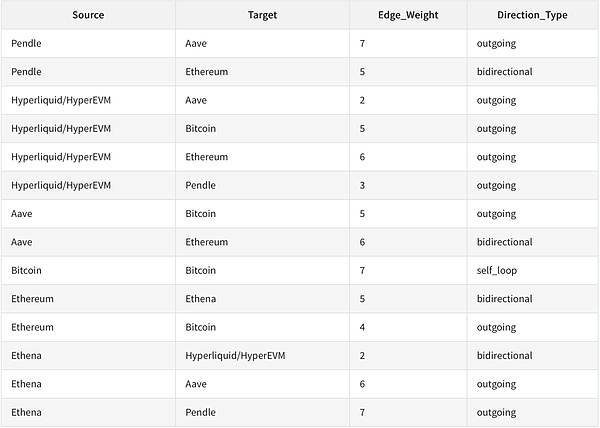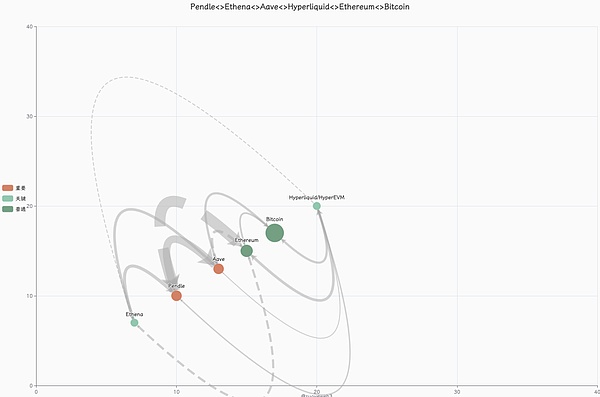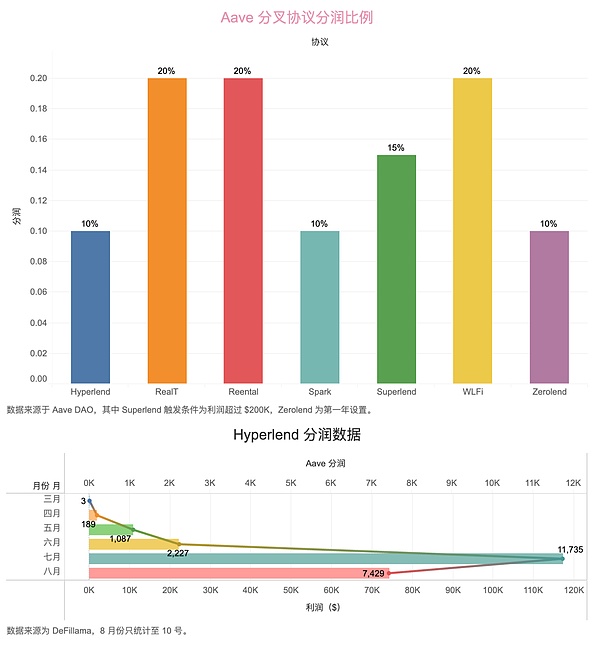
Connectionism, power law inflation of on-chain assets
Ethereum has returned with DeFi again, and Aave/Pendle/Ethena makes revolving lending a leverage amplifier. Compared with the on-chain stack based on ETH, the leverage upward curve supported by stablecoins such as USDe is a more smooth.
We may enter a warm long cycle, and the investigation of on-chain protocols will be divided into two parts. One is to involve more asset types, and external liquidity will be more abundant under the expectation of the Federal Reserve’s interest rate cut; the other is to examine the limit value of the leverage multiple, which corresponds to the process of safe deleveraging, that is, how individuals can exit safely and how the bull market will end.
Six Crypto Protocols: Ecosystem and Token Interaction
There are countless on-chain protocols and assets, but under the 28th rule, we only need to pay attention to the parameters of TVL/trading volume/token price, and focus more on the smallest individuals that are indispensable to the on-chain ecology, and then examine their relationships in the ecological network to take into account the new protocol with the highest individual importance, ecological linkage and growth potential.

Image description: DeFi TVL Overview
Image source: @zuoyeweb3
In terms of DeFi TVL composition, Ethereum accounted for more than 60% of DeFi TVL in July, and Aave accounted for more than 60% of the Ethereum Ecological TVL. This is 20% of the 28th rule. The remaining protocols must have strong connections with the two before they can be included in the ranks of active and passive beneficiaries.
With the launch of the flywheel of the three musketeers of the revolving loan, it is not necessary to say that the correlation between Ethereum, Aave, Pendle and Ethena continues to add Bitcoin. WBTC, ETH and USDT/USDC are de facto underlying assets, but USDT/USDC are similar to Lido. They only have asset attributes and basically do not have ecological value. Plasma, Stablechain and others have just begun to compete.
For a little difference, a protocol can have multiple values. For example, Bitcoin basically only has asset value, that is, everyone needs BTC, but no one knows how to use the Bitcoin ecosystem. It is not said that BTCFi is a scam (dog head saves life).
ETH/Ethereum has dual value. Everyone needs both ETH and Ethereum network, including EVM and its extensive DeFi stack and development facilities.
According to further division of assets and ecological values, the degree of “needed” of each leader agreement is examined. The attributes of the required assets are scored and the ecological value is scored. The following table can be summarized:

Pendle/Aave/Ethena/Ethereum/HyperEVM/Bitcoin are the six most powerful protocols. The relationships between any two can be coupled to each other, and at most an additional protocol or asset link is required.
Let’s explain a little:
-
1. Ethena <> HyperEVM: USDe has been deployed to the HyperEVM ecosystem
-
2. Pendle <> HyperEVM: $kHYPE and $hbHYPE are ranked first and third in trend list
-
3. Aave <> HyperEVM: Hyperlend TVL accounts for 25% of HyperEVM ($500M vs. $2B), which is a friendly fork of Aave, promising 10% of profits to Aave
-
4. BTC/ETH are the two currencies with the largest trading volume of Hyperliquid, and can be recharged and withdrawn through Unit Protocol.
-
5. Pendle, Aave, and Ethena have become one, but the asset attributes of USDe have been recognized, and the ecological value of $ENA is slightly inferior.
-
6. Pendle’s new product Boros uses capital rates as the basis for trading, and the first choice is BTC and ETH contracts.
-
7. Aave requires WBTC and various ETH, such as pledging ETH, especially the ecological value of Ethereum as an infrastructure is needed by Aave/Pendle/Ethena, which is the on-chain support of ETH price.
-
8. The most special thing here is that the Ethereum ecosystem requires BTC in one direction, and the Bitcoin ecosystem does not require any external assets.
-
9. Ethena has nothing to do with Bitcoin/BTC
-
10. HyperEVM/Hyperliquid is the “most proactive” external ecosystem, with a sense of “I am here to join this home”
According to statistics, these are the six most closely linked assets. The introduction of any other ecosystem and tokens requires more hypothetical steps. For example, the relationship between Lido, the second TVL, and Hyperliquid and Bitcoin, is very weak, and after Pendle “abandons” the LST assets and switches to YBS, Lido’s ecological linkage attributes within Ethereum will weaken.
Based on the top 7 BTC, we divide 6 assets into three nodes based on the influence on other protocols. Please note that this is not a depiction of the value of its assets, but a ranking of importance within the ecosystem:

BTC/ETH is the strongest infrastructure. BTC wins in value attributes. The ETH ecological status is unshakable. You can add Solana to calculate the link level, and you will find that it is not as good as Hyperliquid/HyperEVM’s link to Ethereum. The core reason is the transaction attributes of Hyperliquid itself, and combined with HyperEVM, it is more in line with the EVM ecosystem.
-
• In Ethereum, Lido/Sky has insufficient interaction with the existing six protocols
-
• In addition to Ethereum, Solana/Aptos has insufficient interaction with the existing six protocols
However, Solana needs to support its own DEX to be compatible with more external assets. The required assumption steps will naturally be more, and SVM compatible with EVM ecosystem will be more difficult. In a word, everything about Solana must develop independently.

Image description: Connectionism
Image source: @zuoyeweb3
However, in the relationship network, the synergy effect of the Ethereum ecosystem is the strongest. The $1 Ethena is hedged through ETH and then enters Pendle and Aave for value flow, and the Gas Fee generated on it becomes the value support for ETH.
In addition to Bitcoin’s natural self-circulation and self-circulation of value through BTC, ETH is closest to the value closed loop, but this is the result of proactive actions. The combination of Hyperliquid/HyperEVM is still on the way. It will take some time to complete the linkage between transactions (Hyperliquid) + ecology (HyperEVM) and $HYPE.
This is a process of entropy increase assumptions gradually increase. BTC only needs itself, ETH needs ecology and tokens, and $HYPE needs transactions, tokens and ecology.
Is DeFi’s expansion an end?
As mentioned earlier, Hyperlend needs to give Aave money, and Aave’s influence is not limited to this. In fact, Aave is the protagonist of the revolving loan initiated by Pendle and Ethena, and it assumes the leverage of the entire revolving system.
Aave is the closest existence to becoming an Ethereum chain infrastructure. This is not because of its highest TVL, but because of the comprehensive consideration of security and capital volume. With any public chain and ecosystem, the safest way to start the lending model is to comply fork Aave.

Image description: Aave and Hyperlend split settings
Image source: @zuoyeweb3
In Hyperlend’s fork template, 10% of the profit is the basis, and there is also the distribution of its own tokens 3.5% to Aave DAO and 1% stAave holders, that is, Aave sells itself as a service to various ecology, which is the linkage between its ecological value and token value.
But it is not without competitors. Maple has expanded to HyperEVM. New forms of lending agreements such as Fluid and Morpho are also very popular with new assets such as YBS. HyperEVM, as the strongest competitor in the Ethereum EVM ecosystem, may not always remain peaceful.
In terms of initiative, Bitcoin and HyperEVM are the two absolute extremes. HyperEVM is siphoning the traditional transaction type on the chain through HIP3 siphoning, connecting the liquidity of HyperCore and Hyperevm through CoreWriter, and supporting its own front-end agents through Builder Code.
In addition, Unit Protocol and Phantom are used to open up the funds of the Solana ecosystem and siphon all on-chain liquidity, which is also a way to expand infrastructure.
To summarize:
-
• Pendle aims at all types of assets that can be split, and expands the derivatives market outside of perpetual contracts from fixed income, that is, the interest rate swap market in a broad sense
-
• Ethena uses the DeFi revolving lending model and treasury strategy to build the third pole of stablecoin from the core of $ENA and $USDe and $USDtb. The basic purpose of USDT/USDC is still transactions and payments. USDe hopes to become a risk-free asset in the DeFi field.
-
• Aave is already a de facto lending infrastructure, and its status is closely linked to Ethereum
-
• Bitcoin and Ethereum represent the limits of the blockchain economic system. The extent of expansion is the basis of DeFi growth, that is, how much BTC scale can be moved to DeFi and how big the growth range does DeFi still have.
-
• Hyperliquid/HyperEVM has been closely bound to existing DeFi giants in the ecosystem. Although TVL is far inferior to Solana, its growth prospects are greater. Solana’s story lies in defeating the EVM system from the perspective of public chains.
Conclusion
The six encryption protocols examine the degree of linkage between each other, not that other protocols lack value, but that high collaboration density will increase the degree of freedom and utilization of funds exponentially, and then share the same amount of rain and dew, and prosper together.
Of course, loss will also lead to losses. This requires examining the subsequent development of DeFi anchor exchange – switching from ETH to YBS. As a high-value asset, ETH is more radical in leverage ratio. For example, YBS, such as USDe, is naturally more stable (not value), and DeFi Lego based on it is more stable. Apart from extreme deaning, the curve of leverage and deleveraging can theoretically make the curve of leverage and deleveraging more moderate.
The seats in the Encrypted Temple of Gods are limited, and the new Selected One can only strive to move forward, make friends with existing gods, and create the strongest agreement network so that they can gain a place for themselves.







